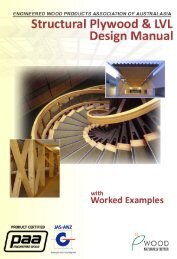Facts About Particleboard and MDF - Engineered Wood Products ...
Facts About Particleboard and MDF - Engineered Wood Products ...
Facts About Particleboard and MDF - Engineered Wood Products ...
Create successful ePaper yourself
Turn your PDF publications into a flip-book with our unique Google optimized e-Paper software.
The moisture content of <strong>Particleboard</strong> <strong>and</strong> <strong>MDF</strong> when it leaves the factory is usually 7-10%. The following<br />
table gives approximate levels for different relative humidity of the surrounding air.<br />
Relative Humidity<br />
Approximate Moisture<br />
Content<br />
30% 6 - 8%<br />
45% 7 - 9%<br />
65% 9 - 11%<br />
75% 10 - 12%<br />
90% 15 - 16%<br />
These levels can only be taken as a general guide <strong>and</strong> will vary with type <strong>and</strong> density of board.<br />
Long term storage in damp conditions can cause roughening of the surface <strong>and</strong> damage to the edge of the<br />
board.<br />
Once boards are laid they will gradually attain the moisture content dictated by the atmosphere within the<br />
building. Although it is not possible to give precise levels the figures below give a general indication of the<br />
moisture content of boards in various conditions.<br />
Building with central heating 7 - 9%<br />
Building with intermittent central heating 9-10%<br />
Unheated new building up to 14%<br />
Any increase in moisture content will cause some slight expansion in the boards although again this cannot<br />
be precisely defined, as a rough guide an increase in moisture content:<br />
<br />
<br />
from 9% to 12% will increase length <strong>and</strong> width 1mm per metre run<br />
from 12% to 16% a further 1mm increase per metre run<br />
Design precautions necessary to accommodate movement of the board are contained in the relevant<br />
Application & Installation sheets, available from the EWPAA web site.<br />
Storage Conditions<br />
Boards should preferably be stored in an enclosed dry building. Where temporary storage outside cannot be<br />
avoided then the stacks should be covered with heavy-duty polythene or tarpaulin keeping all boards well<br />
clear of the ground.<br />
If boards are to be stored in the building or room in which they are to be used it is recommended that they<br />
are conditioned by stacking each sheet to allow free circulation of air. This will allow them to achieve a<br />
moisture content in balance with the surrounding air.<br />
37

















